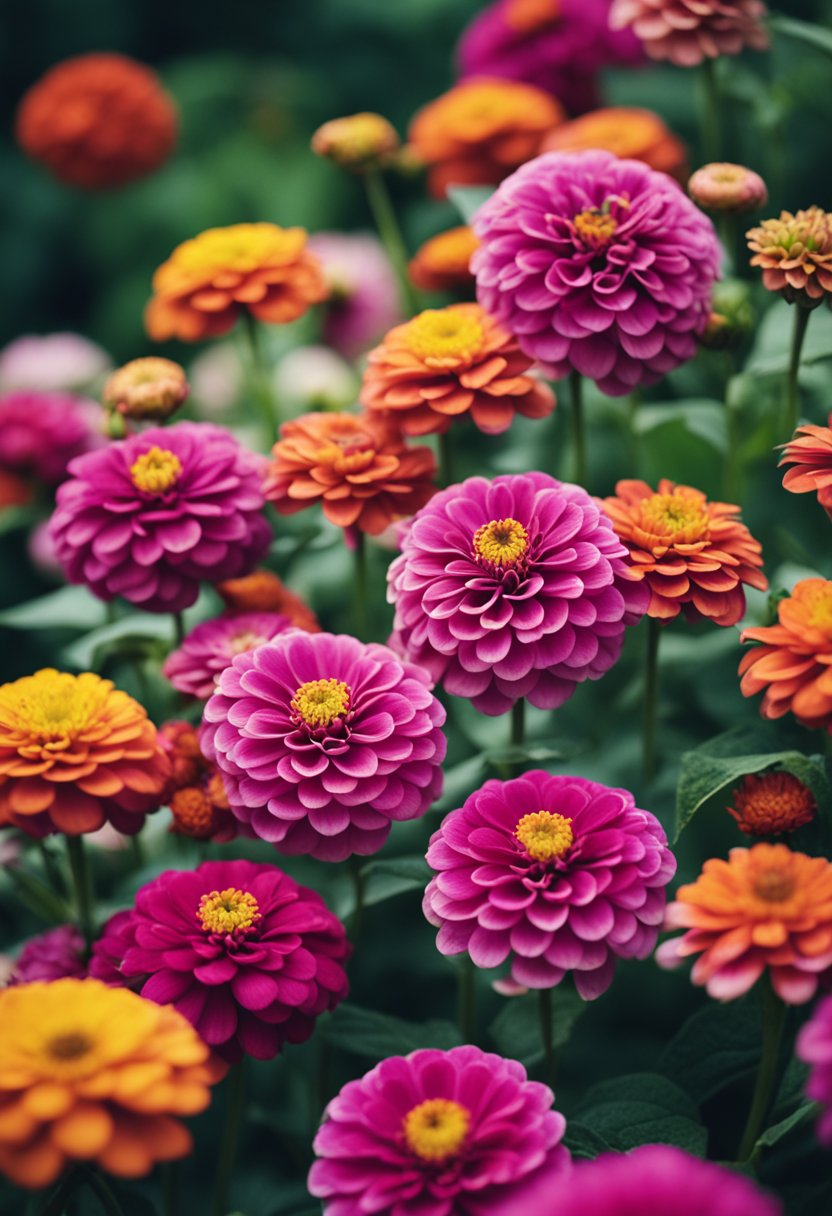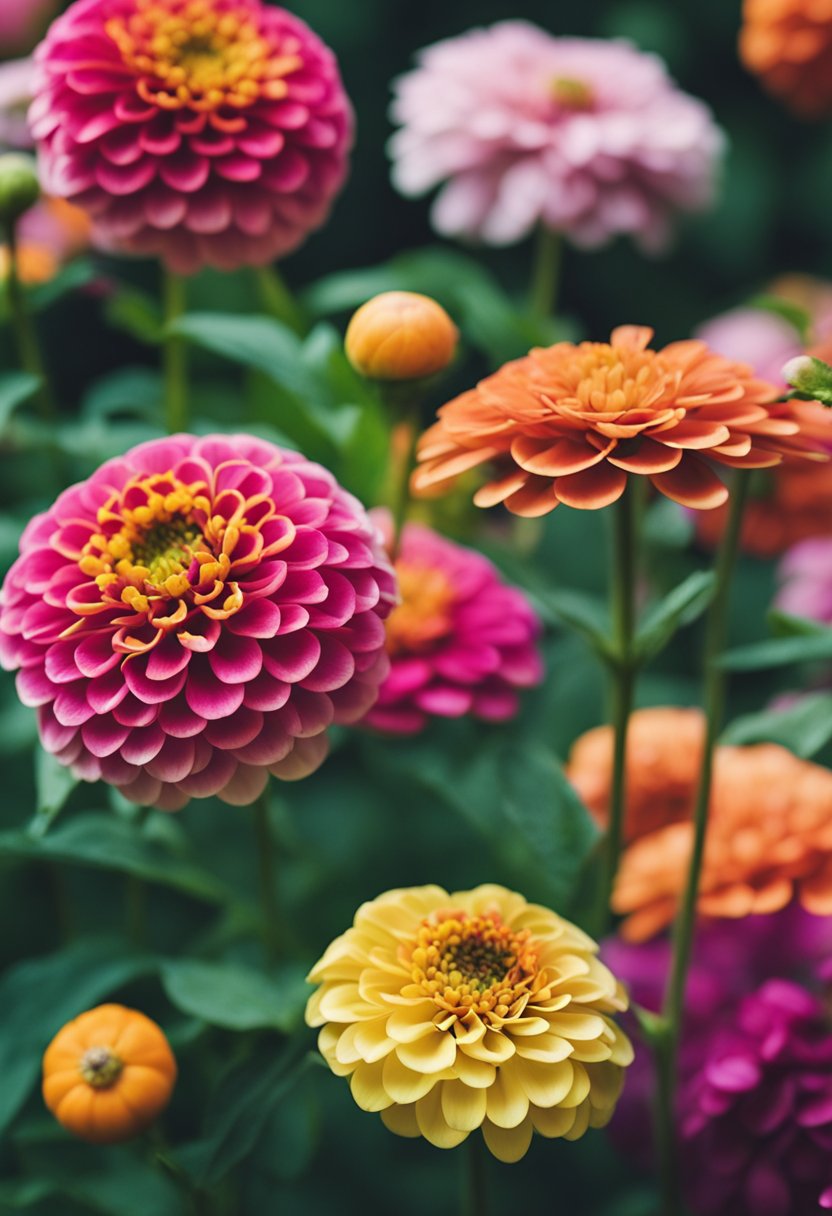Do you want to keep your zinnias blooming all season long? Deadheading is the key! Deadheading is the process of removing spent flowers from a plant to encourage more blooms. In this article, we’ll cover the basics of how to deadhead zinnias to keep your garden looking its best.
This post may contain affiliate links.
Zinnias are a popular choice for many gardeners due to their bright colors, long-lasting blooms, and easy maintenance. Deadheading zinnias is a simple task that can make a big difference in the appearance of your garden.
By removing spent flowers, you’ll not only encourage new growth but also prevent the plant from putting energy into producing seeds. This energy can then be used to produce more blooms, resulting in a fuller, healthier plant.
Related Article: How to Save Seeds from Zinnias: A Beginner’s Guide
Understanding Deadheading
If you want to keep your zinnias blooming all season long, deadheading is a must. Deadheading is the process of removing spent blooms from the plant. Doing so can help promote new growth and ensure that your zinnias continue to produce beautiful blooms throughout the growing season.
Benefits of Deadheading Zinnias
Deadheading zinnias has several benefits. First and foremost, it helps to conserve the plant’s energy. When a zinnia flower dies, the plant will begin to focus its energy on producing seeds.
By deadheading, you remove the spent blooms before they can go to seed, allowing the plant to redirect its energy towards producing new growth and more flowers.
Deadheading can also help to keep your zinnias looking neat and tidy. As the plant produces new blooms, the old ones can become unsightly and detract from the overall appearance of the plant. By removing them, you can keep your zinnias looking healthy and attractive.
Related Article: When to Pinch Zinnias: A Quick Guide
Burpee Cut & Come Again Zinnia Seeds 175 seeds
When to Deadhead
Knowing when to deadhead your zinnias is crucial. You should deadhead your zinnias as soon as the blooms begin to fade. This will prevent the plant from wasting energy on producing seeds and allow it to focus on producing new growth.
To deadhead your zinnias, simply pinch or cut off the spent bloom just above the first set of leaves. Be sure to use clean, sharp pruning shears to avoid damaging the plant.
Deadheading should be done regularly throughout the growing season to ensure that your zinnias continue to produce beautiful blooms.
Identifying Spent Blooms
When it comes to deadheading zinnias, the first step is to identify which blooms are spent and need to be removed. This can be a bit tricky, especially if you’re new to gardening, but with a little practice, you’ll soon be able to spot them easily.
Recognizing Faded Flowers
One of the easiest ways to identify spent blooms is to look for flowers that have started to fade in color. Zinnias come in a wide range of colors, so it’s important to pay attention to the specific shade of each bloom.
As a flower starts to fade, the color will become less vibrant and may even start to look a bit washed out.
Signs of Wilting and Fading
Another sign that a zinnia bloom is spent is wilting or fading. As a bloom reaches the end of its life cycle, it may start to droop or wilt, and the petals may become limp or even fall off. This is a clear indication that it’s time to deadhead the flower.
To make sure you’re identifying spent blooms correctly, it’s a good idea to check your zinnias regularly.
This will help you catch fading or wilting blooms early on, before they have a chance to go to seed and start producing new flowers. By deadheading regularly, you’ll keep your zinnias looking healthy and vibrant all season long.

Proper Deadheading Technique
Deadheading zinnias is an essential gardening task that helps to promote longer blooming periods and healthier plants. Here are some tips to help you deadhead your zinnias properly.
Using the Right Tools
Before you begin deadheading, make sure you have the right tools. A pair of sharp scissors or pruners is essential for making clean cuts that won’t damage the plant.
If you’re deadheading a lot of zinnias, consider investing in a pair of pruning shears, which will make the job faster and easier.
It’s also a good idea to wear gloves to protect your hands from thorns and other sharp plant parts.
Step-by-Step Deadheading
- Identify the node: Look for the point on the stem where the flower head meets the stem. This is called the node.
- Cut the stem: Using your scissors or pruners, make a clean cut just above the node. Be sure to cut at an angle to prevent water from pooling on the cut surface.
- Remove the flower head: Once you’ve made the cut, remove the flower head from the stem. You can do this by gently pulling it off or by using your scissors or pruners to snip it off.
- Repeat: Continue deadheading your zinnias in this way, working your way around the plant and removing all the spent flower heads.
Remember to deadhead your zinnias regularly to keep them looking their best. By removing spent flower heads, you’ll encourage the plant to produce more blooms, which means more cut flowers for you to enjoy!

Caring for Zinnias After Deadheading
After deadheading your zinnias, it’s important to continue caring for them properly to ensure they continue to produce new blooms and maintain their vibrant colors. Here are some tips to help you care for your zinnias after deadheading:
Watering and Fertilizing
Zinnias require regular watering to keep the soil moist but not waterlogged. Water your zinnias deeply once a week, making sure the water reaches the roots. During hot and dry weather, you may need to water more frequently.
Fertilizing your zinnias is also important to promote healthy growth and vibrant colors. Use a balanced fertilizer once a month, following the instructions on the package. Avoid over-fertilizing, as this can lead to excessive foliage growth and fewer blooms.
Preventing Diseases and Pests
Keeping your zinnias healthy and free from diseases and pests is essential for their continued growth and beauty. Here are some tips to help prevent common issues:
- Provide adequate sunlight and air circulation to prevent fungal diseases.
- Avoid overhead watering, which can promote fungal growth.
- Remove any diseased or damaged leaves or flowers promptly to prevent the spread of disease.
- Monitor your zinnias for pests such as aphids, spider mites, and caterpillars. Use insecticidal soap or neem oil to control infestations.
By following these simple tips, you can help your zinnias thrive and continue to produce new blooms throughout the growing season. Happy gardening!
Encouraging Continuous Blooming
Zinnias are a beautiful addition to any garden, and deadheading them is a great way to encourage continuous blooming. Here are some tips to help you promote bushier growth and produce more flowers.
Promoting Bushier Growth
To promote bushier growth, pinch off the tips of the stems when the plants are young. This will encourage the plant to branch out and produce more flowers. Pinching can also help to keep the plant compact and prevent it from getting too tall and leggy.
Another way to promote bushier growth is to make sure your zinnias are getting enough sunlight. Zinnias thrive in full sun, so make sure they are getting at least six hours of direct sunlight each day.
Timing for Reblooming
To keep your zinnias blooming all season long, it’s important to deadhead them regularly. Deadheading is the process of removing spent blooms from the plant to encourage new flowers to grow.
The best time to deadhead zinnias is when the flowers are starting to fade. Simply cut off the old flower, making sure to remove the entire stem. This will encourage the plant to produce more flowers and keep it looking neat and tidy.
If you want to try a cut-and-come-again approach, you can wait until the flowers have fully bloomed before cutting them. This will allow you to enjoy the flowers indoors before the plant produces new ones.
Frequently Asked Questions
What is the proper technique for deadheading zinnias in containers?
To deadhead zinnias in containers, you should use sharp scissors or pruning shears to cut off the spent blooms. Cut the stem just above the first set of leaves below the flower. This will encourage new growth and more blooms.
Can I collect seeds after deadheading my zinnias?
Yes, you can collect seeds after deadheading your zinnias. Allow the spent blooms to dry on the plant, and then remove the seeds from the flower head. Store the seeds in a cool, dry place until you are ready to plant them.
Is it necessary to deadhead zinnias to encourage blooming?
Yes, deadheading zinnias is necessary to encourage blooming. When you remove the spent blooms, you are signaling to the plant to produce more flowers. If you don’t deadhead your zinnias, the plant will put its energy into producing seeds instead of new blooms.
What should I do with my zinnias when the growing season is over?
When the growing season is over, you should remove your zinnias from the container and discard them. Zinnias are annuals, which means they only live for one growing season. You can save the seeds from your zinnias to plant next year.
What are the consequences of not deadheading zinnias?
If you don’t deadhead your zinnias, the plant will put its energy into producing seeds instead of new blooms. This will result in fewer flowers and a shorter blooming period.
Will zinnias regrow if they are cut back?
Yes, zinnias will regrow if they are cut back. In fact, cutting back zinnias can help to encourage new growth and more blooms. When you cut back the plant, it signals to the plant to produce new growth.
Follow my zinnia garden board on Pinterest.




